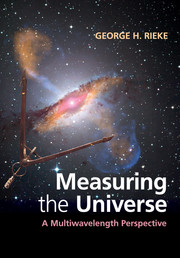Book contents
- Frontmatter
- Contents
- Preface
- 1 Radiometry, optics, statistics
- 2 Telescopes
- 3 Detectors for the ultraviolet through the infrared
- 4 Optical and infrared imaging; astrometry
- 5 Photometry and polarimetry
- 6 Spectroscopy
- 7 Adaptive optics and high-contrast imaging
- 8 Submillimeter and radio astronomy
- 9 Interferometry and aperture synthesis
- 10 X- and gamma-ray astronomy
- 11 Epilogue: cosmic rays, neutrinos, gravitational waves
- Appendix A Useful constants
- Appendix B Common Fourier transforms and relations
- References
- Index
- References
3 - Detectors for the ultraviolet through the infrared
Published online by Cambridge University Press: 05 November 2012
- Frontmatter
- Contents
- Preface
- 1 Radiometry, optics, statistics
- 2 Telescopes
- 3 Detectors for the ultraviolet through the infrared
- 4 Optical and infrared imaging; astrometry
- 5 Photometry and polarimetry
- 6 Spectroscopy
- 7 Adaptive optics and high-contrast imaging
- 8 Submillimeter and radio astronomy
- 9 Interferometry and aperture synthesis
- 10 X- and gamma-ray astronomy
- 11 Epilogue: cosmic rays, neutrinos, gravitational waves
- Appendix A Useful constants
- Appendix B Common Fourier transforms and relations
- References
- Index
- References
Summary
Basic properties of photodetectors
For nearly a century, photography was central to huge advances in astronomy. Photographic plates were the first detectors that could accumulate long integrations and could store the results for in-depth analysis away from the telescope. They had three major shortcomings, however: (1) they have poor DQE; (2) their response can be nonlinear and complex; and (3) it is impossible to obtain repeated exposures with the identical detector array, an essential step toward quantitative understanding of subtle signals. The further advances with electronic detectors arise largely because they have overcome these shortcomings.
Modern photon detectors operate by placing a bias voltage across a semiconductor crystal, illuminating it with light, and measuring the resulting photo-current. There are a variety of implementations, but an underlying principle is to improve the performance by separating the region of the device responsible for the photon absorption from the one that provides the high electrical resistance needed to minimize noise. Nearly all of these detector types can be fabricated in large-format two-dimensional arrays with multiplexing electrical readout circuits that deliver the signals from the individual detectors, or pixels, in a time sequence. Such devices dominate in the ultraviolet, visible, and near- and mid-infrared. Our discussion describes: (1) the solid-state physics around the absorption process (Section 3.2); (2) basic detector properties (Section 3.3); (3) infrared detectors (Section 3.4); (4) infrared arrays and readouts (Section 3.5); and charge coupled devices (CCDs – Section 3.6). This chapter also describes image intensifiers as used in the ultraviolet, and photomultipliers (Section 3.7). Heritage detectors that operate on other principles are discussed elsewhere (e.g., Rieke 2003, Kitchin 2008).
- Type
- Chapter
- Information
- Measuring the UniverseA Multiwavelength Perspective, pp. 58 - 91Publisher: Cambridge University PressPrint publication year: 2012
References
- 1
- Cited by



